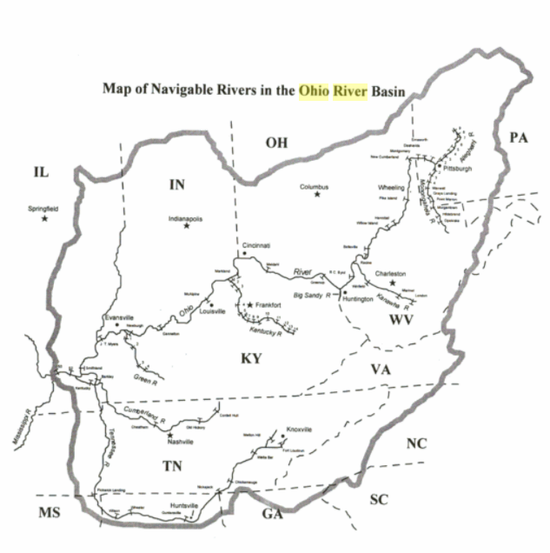Ohio River: Difference between revisions
Jump to navigation
Jump to search

imported>George Swan (more details) |
mNo edit summary |
||
| (12 intermediate revisions by 4 users not shown) | |||
| Line 1: | Line 1: | ||
{{subpages}} | {{subpages}} | ||
{{image | Navigable branches of the Ohio River, from 1897, from the US Army Corps of Engineers.png | right | | {{dambigbox|Ohio River|Ohio}} | ||
{{image | Navigable branches of the Ohio River, from 1897, from the US Army Corps of Engineers.png | right | 550px | Navigable branches of the Ohio River, from 1897, from the US Army Corps of Engineers.}} | |||
The Ohio River drains a basin of | The '''Ohio River''' is the largest tributary of the [[Mississippi River]], by volume. It flows for 981 miles from Pittsburgh to where the river empties into the Mississippi at [[Cairo, Illinois]]. | ||
The Ohio River drains a basin of 204,000 square miles.<ref name=usaceOhio1983-01/> The [[Allegheny River|Allegheny]] and [[Monongahela River|Monongahela]] rivers meet at what is now [[Pittsburgh, Pennsylvania]], to form the Ohio.<ref name=usaceNavigationHistory/> Other tributaries include the [[Green River (Ohio)|Green]], [[Cumberland River|Cumberland]], [[Tennessee River|Tennessee]], [[Beaver River (Ohio)|Beaver]], [[Muskingum River|Muskingum]], [[Scioto River|Scioto]], [[Miami River|Miami]], and [[Wabash River|Wabash]] rivers. | |||
Before engineers built locks, and dredged shallow reaches, the river's average speed was five miles per hour.<ref name=usaceOhio1983-01/> | |||
The [[Falls of the Ohio]], at present day [[Louisville, Kentucky]], was the only navigational obstacle on the Ohio, until it was circumvented by a canal. | |||
==References== | ==References== | ||
| Line 30: | Line 36: | ||
</ref> | </ref> | ||
}} | }}[[Category:Suggestion Bot Tag]] | ||
Latest revision as of 07:00, 28 September 2024
This article is about Ohio River. For other uses of the term Ohio, please see Ohio (disambiguation).
The Ohio River is the largest tributary of the Mississippi River, by volume. It flows for 981 miles from Pittsburgh to where the river empties into the Mississippi at Cairo, Illinois.
The Ohio River drains a basin of 204,000 square miles.[1] The Allegheny and Monongahela rivers meet at what is now Pittsburgh, Pennsylvania, to form the Ohio.[2] Other tributaries include the Green, Cumberland, Tennessee, Beaver, Muskingum, Scioto, Miami, and Wabash rivers.
Before engineers built locks, and dredged shallow reaches, the river's average speed was five miles per hour.[1]
The Falls of the Ohio, at present day Louisville, Kentucky, was the only navigational obstacle on the Ohio, until it was circumvented by a canal.
References
- ↑ 1.0 1.1 Michael C. Robinson (January 1983). History of Navigation in the Ohio River Basin. US Army Corps of Engineers. Retrieved on 2021-03-15.
